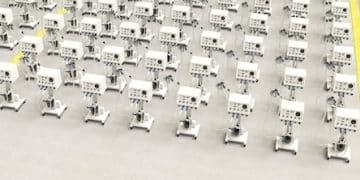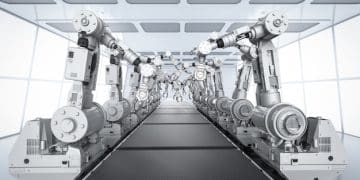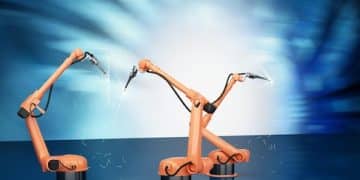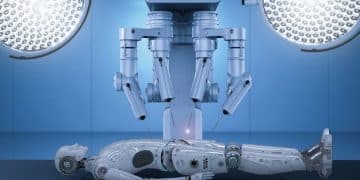Robotics Startups to Watch in the US: Industry Disruptors
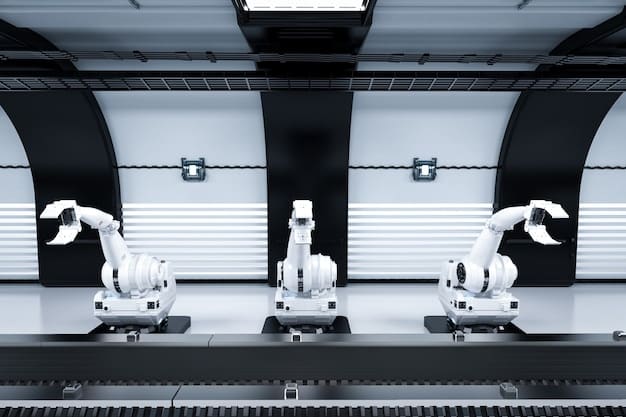
The United States stands at the forefront of robotic innovation, with a dynamic ecosystem of startups poised to revolutionize industries from healthcare and logistics to manufacturing and exploration, leveraging cutting-edge AI, machine learning, and advanced automation to solve complex challenges and redefine operational paradigms.
The landscape of technological innovation is in constant flux, with new frontiers emerging daily. Among these, robotics, propelled by advancements in artificial intelligence and automation, is rapidly transforming various sectors. For those keenly observing this evolution, identifying the Robotics Startups to Watch in the US: Innovations Disrupting the Industry offers a compelling glimpse into the future. These nascent companies are not merely refining existing technologies but are fundamentally reshaping how industries operate, promising efficiencies, capabilities, and solutions previously confined to the realm of science fiction.
The Dawn of a New Robotic Era
The robotics industry in the United States is experiencing an unprecedented surge, driven by robust investment, a rich talent pool, and a culture of innovation. This segment introduces the foundational shifts enabling these startups to flourish, emphasizing the technological breakthroughs that empower them. From collaborative robots designed to work alongside humans to fully autonomous systems navigating complex environments, the scope of robotic applications is broadening dramatically. This era is defined not just by what robots can do, but by how they seamlessly integrate into our lives and workflows, augmenting human potential and solving critical challenges.
Driving Forces Behind Robotics Innovation
Several key factors are fueling the rapid expansion and diversification of robotics startups across the US. Access to venture capital, particularly in tech hubs like Silicon Valley, Boston, and Pittsburgh, provides the necessary funding for research, development, and scaling. Furthermore, the convergence of technologies such as artificial intelligence, machine learning, computer vision, and advanced sensor technology empowers these startups to create robots that are more intelligent, adaptable, and versatile than ever before. This synergy allows for tailored solutions addressing specific industry needs. The availability of skilled engineers, researchers, and entrepreneurs, often emerging from strong university programs and established tech companies, forms the invaluable human capital driving these innovations.
Technological Integration and Market Impact
The true disruptive potential of these startups lies in their ability to integrate complex technologies into practical, scalable solutions. This integration extends beyond mere automation, venturing into areas like human-robot interaction, ethical AI, and data security. The market impact is already palpable across various sectors, demonstrating improved safety, efficiency, and resource utilization.
- Healthcare Transformation: Robots are assisting in surgeries, delivering medications, and providing patient support, easing burdens on healthcare professionals.
- Logistics and Supply Chain Optimization: Autonomous mobile robots (AMRs) are streamlining warehouse operations, improving inventory management and delivery speeds.
- Manufacturing Reinvention: Collaborative robots (cobots) enhance productivity and precision in assembly lines, working safely alongside human colleagues.
- Agriculture Modernization: Robotic systems are performing tasks like precise planting, harvesting, and pest control, boosting yields and sustainability.
These advancements are not just incremental; they represent fundamental shifts in operational paradigms, allowing companies to reimagine their processes and achieve unprecedented levels of performance. The emphasis is on creating value through automation, freeing human workers for more complex and creative tasks.
Pioneers in Industrial Automation and Manufacturing
The industrial sector has historically been an early adopter of robotics, and this trend continues with a new wave of startups pushing the boundaries of automation. This section highlights companies that are reshaping manufacturing processes, enhancing precision, and improving worker safety through innovative robotic solutions. These pioneers are addressing critical needs such as labor shortages, increasing demand for customized products, and the drive for greater operational efficiency. Their work extends from advanced robotic arms for assembly to sophisticated vision systems for quality control, underpinning the next generation of smart factories.
Rethinking the Factory Floor
Modern manufacturing demands flexibility, speed, and precision. Startups in this domain are developing robots that can seamlessly integrate into existing factory setups, often requiring minimal restructuring. They focus on solutions that handle intricate tasks, reduce waste, and operate in hazardous environments, thereby enhancing overall productivity and safety. Companies are exploring robotic systems for a wide range of applications, including additive manufacturing, material handling, and quality inspection. This shift is turning factories into dynamic, intelligent ecosystems where humans and robots collaborate effectively.
Key Innovations and Applications
The innovations coming from these startups are diverse, reflecting the complexity of industrial automation. One area of significant focus is the development of robotic systems capable of performing highly dexterous and precise tasks. This includes robots that can manage micro-assembly, delicate handling of components, and intricate welding. Another critical area is the deployment of autonomous systems for logistics within manufacturing facilities, ensuring that parts and finished goods move efficiently.
- Collaborative Robots (Cobots): Designed for direct human-robot interaction without safety cages, enhancing productivity in shared workspaces.
- AI-Powered Vision Systems: Enabling robots to perform detailed inspections, detect defects, and ensure product quality with unprecedented accuracy.
- Adaptive Robotics: Robots that can learn and adjust to variable tasks and environments, increasing flexibility in production lines.
These technologies are not only making manufacturing more efficient but also contributing to a safer working environment. By automating repetitive or dangerous tasks, these startups are allowing human workers to focus on higher-value activities that require problem-solving and critical thinking. The competitive edge provided by these innovations is crucial for US manufacturers aiming to remain globally competitive.
Healthcare Robotics: Precision, Care, and Efficiency
The healthcare industry is witnessing a profound transformation driven by robotics. Startups in this space are developing solutions that enhance surgical precision, automate tedious tasks, improve patient care, and streamline hospital operations. This section delves into the companies at the forefront of medical robotics, from surgical assistants to therapeutic devices, illustrating how technology is bringing unparalleled efficiency and accuracy to healthcare delivery. The promise of these innovations lies in their ability to improve patient outcomes while simultaneously reducing costs and optimizing the use of medical professionals’ time.
Revolutionizing Medical Procedures and Logistics
Robots are becoming indispensable tools in modern hospitals and clinics. In surgical suites, robotic systems provide surgeons with enhanced dexterity, visualization, and precision, leading to minimally invasive procedures and faster patient recovery times. Beyond the operating room, robots are also addressing logistical challenges within healthcare facilities, such as delivering medications, transporting lab samples, and managing inventory. This automation frees up nurses and other staff from routine, non-patient-facing duties, allowing them to dedicate more time to direct patient care, thereby improving overall hospital efficiency and patient satisfaction.
Groundbreaking Applications and Companies
The scope of healthcare robotics is rapidly expanding, with innovations touching nearly every aspect of the patient journey. From point-of-care diagnostics to rehabilitation, the impact is significant.
- Surgical Robotics: Systems that assist surgeons with intricate procedures, offering greater control and precision.
- Rehabilitation Robotics: Devices designed to aid patients in recovery from injuries or strokes, providing tailored therapy and monitoring progress.
- Pharmacy and Lab Automation: Robots that manage prescriptions, prepare medications, and process lab samples, minimizing human error and increasing throughput.
- Telepresence Robots: Enabling remote consultations and monitoring, particularly useful in providing care to underserved areas or during public health crises.

These startups are not only developing advanced hardware but also integrating sophisticated AI algorithms to provide intelligent support and personalized care. The ethical implications and regulatory hurdles are significant, but the potential benefits for patients and healthcare systems worldwide are immense, making this a high-impact area for robotic innovation.
Logistics and Supply Chain Automation: The Autonomous Future
The backbone of the global economy, logistics and supply chain management, is undergoing a profound revolution powered by robotics. Startups in this domain are deploying autonomous mobile robots (AMRs), automated guided vehicles (AGVs), and sophisticated robotic arms to optimize warehousing, automate last-mile delivery, and enhance inventory management. This section examines the leading innovators creating smarter, faster, and more efficient supply chains, addressing challenges such as labor shortages, increasing e-commerce demand, and the need for greater resilience and transparency in distribution networks.
Optimizing Warehousing and Delivery
The demands of modern e-commerce have pushed logistics operations to their limits. Robotics provide a scalable solution to handle the massive volume of goods, accelerating picking, packing, and sorting processes. Autonomous robots navigate warehouse floors, transport goods, and even load and unload trucks, drastically reducing human effort and improving speed. This automation minimizes errors and allows for 24/7 operation, crucial for meeting tight delivery windows. For the last mile, innovative delivery robots and drones are being developed to navigate urban and suburban environments, promising faster and more cost-effective delivery options.
Innovations Driving Efficiency
The transformation of logistics is multifaceted, involving a range of robotic applications designed to enhance every stage of the supply chain. From the moment goods arrive at a distribution center to their final delivery, robots are playing a pivotal role.
- Autonomous Mobile Robots (AMRs): These robots intelligently navigate dynamic environments without fixed routes, optimizing material flow within warehouses.
- Robotic Pick-and-Place Systems: Utilized for high-speed sorting and packaging, these systems increase throughput and reduce errors in fulfillment centers.
- Automated Storage and Retrieval Systems (AS/RS): Robotic cranes and shuttles that manage inventory in high-density storage facilities, maximizing space utilization.
- Last-Mile Delivery Robots: Compact, autonomous vehicles designed to deliver packages directly to consumers, navigating sidewalks and streets.
These technologies not only address the immediate operational challenges but also enable greater visibility and control across the supply chain. By leveraging data collected by these autonomous systems, companies can make more informed decisions, predict demand more accurately, and react swiftly to disruptions, fostering a more resilient and responsive logistics network.
Robotics in Emerging Fields: Agriculture, Energy, and Beyond
Beyond traditional industrial and healthcare applications, robotics are making significant inroads into less conventional but equally vital sectors such as agriculture, energy, and environmental monitoring. This section explores startups that are leveraging robotics to address critical global challenges, including food security, sustainable energy production, and infrastructure maintenance. These innovators are developing specialized robots capable of operating in challenging outdoor environments, under extreme conditions, or in spaces inaccessible to humans, pushing the boundaries of what is possible.
Addressing Global Needs with Specialized Robots
The application of robotics in agriculture is transformative, enabling precision farming that reduces waste and increases yields. Robots can meticulously plant seeds, monitor crop health, target weeds with precision spraying, and even harvest delicate produce, leading to more sustainable and efficient food production. In the energy sector, robots are crucial for inspecting infrastructure like pipelines and wind turbines, performing maintenance in hazardous conditions, and even assisting in the deployment of renewable energy technologies. These specialized robots enhance safety, reduce operational costs, and contribute to environmental stewardship by tackling tasks that are dangerous or inefficient for humans.
Innovative Solutions Across Diverse Industries
The versatility of modern robotics allows for adaptation to a myriad of specific industry requirements. This adaptability is critical for addressing the unique challenges presented by these emerging fields.
- Agricultural Robots: From autonomous tractors equipped with AI vision to delicate fruit-picking robots, enhancing efficiency and sustainability in farming.
- Energy Infrastructure Inspection: Drones and ground robots capable of inspecting vast networks of power lines, solar panels, and wind farms for damage or inefficiencies.
- Environmental Monitoring: Aquatic robots tracking ocean health and atmospheric drones monitoring air quality, collecting vital data for scientific research and policy-making.
- Construction Robotics: Automated systems for precision building, material handling, and surveying, improving safety and accelerating project timelines.
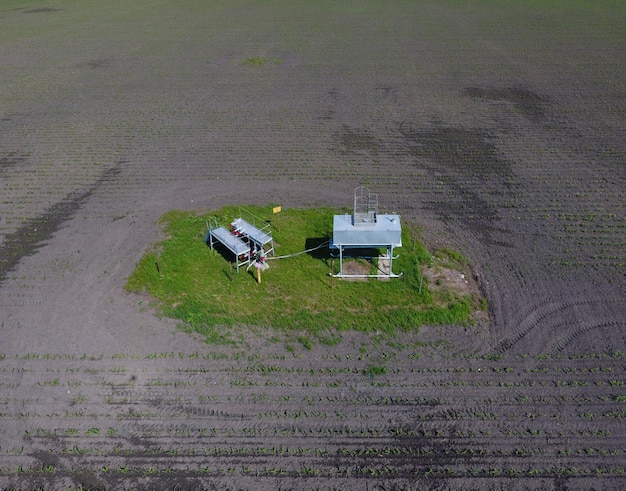
These startups demonstrate the broad potential of robotics to contribute to solving some of humanity’s most pressing issues. Their work underscores a future where intelligent machines play a crucial role in managing our resources, protecting our environment, and ensuring the sustainability of our planet. The development of robust, adaptable, and autonomous systems for these demanding environments represents a significant leap forward in robotic capabilities.
The Future Landscape: Challenges and Opportunities
As robotics continues its rapid ascent, the future landscape presents both exhilarating opportunities and formidable challenges. This section provides a forward-looking perspective on the trajectory of US robotics startups, discussing potential areas for growth, the evolving regulatory environment, ethical considerations, and the ongoing need for a skilled workforce. Understanding these dynamics is crucial for anyone seeking to comprehend the long-term impact and sustainability of this transformative industry. The path forward involves careful navigation of technological advancements, societal integration, and policy development.
Navigating Growth and Ethical Frontiers
The growth trajectory for robotics is steep, fueled by continued innovation in AI, sensor technology, and mechanical engineering. Opportunities abound in new applications, from personalized services and domestic assistance to deep-sea exploration and space colonization. However, this growth also brings challenges. Ethical considerations surrounding robot autonomy, decision-making, and accountability are paramount. The potential impact on employment requires thoughtful policy responses, including investment in workforce retraining and education. There is a continuous need for public engagement and transparent development to build trust and ensure societal acceptance of these advanced technologies.
Key Challenges and Strategic Opportunities
The journey toward a robot-integrated future is not without hurdles. Startups must overcome technical complexities, financial constraints, and market adoption challenges.
- Talent Gap: A persistent shortage of skilled robotics engineers, AI specialists, and data scientists limits growth.
- Regulatory Frameworks: The absence of comprehensive regulations for autonomous systems can create uncertainty and hinder deployment.
- Public Perception: Addressing public concerns about job displacement, privacy, and safety is crucial for widespread adoption.
- Cybersecurity Risks: Protecting robotic systems from cyber threats becomes increasingly vital as they integrate into critical infrastructure.
Despite these challenges, the opportunities are vast. Investing in research and development, fostering public-private partnerships, and developing agile regulatory approaches can accelerate innovation and ensure the responsible deployment of robotics. The ability of US startups to address these challenges while seizing new opportunities will determine their success in shaping the future of industries and societies worldwide. The emphasis will increasingly be on creating robots that augment human capabilities rather than simply replacing them, leading to hybrid workforces where humans and intelligent machines collaborate to achieve unprecedented outcomes.
| Key Point | Brief Description |
|---|---|
| 🚀 Disruptive Innovation | US robotics startups are driving significant changes across various sectors, from manufacturing to healthcare. |
| 💡 Cross-Industry Impact | Robotics is not limited to factories; it’s revolutionizing healthcare, logistics, and even agriculture. |
| 📈 Growth Opportunities | High investment and a strong talent pool contribute to the rapid expansion of the robotics sector. |
| 🌐 Global Challenge Solvers | Robots are addressing critical global issues like food security, sustainable energy, and difficult infrastructure inspections. |
Frequently Asked Questions
▼
A disruptive robotics startup introduces novel solutions that fundamentally alter existing processes or create entirely new markets. This often involves integrating advanced AI, machine learning, and sensor technologies to offer capabilities previously unattainable, improving efficiency, safety, or convenience across industries like manufacturing, healthcare, and logistics.
▼
Key industries being profoundly impacted include manufacturing and industrial automation, healthcare (especially surgical and assistive robotics), logistics and supply chain management (through autonomous mobile robots), and emerging sectors like agriculture and energy infrastructure maintenance. These startups address unique pain points within each domain.
▼
Robotics startups fuel economic growth by creating high-tech jobs, attracting venture capital, and enhancing the competitiveness of US industries. They improve productivity, reduce operational costs, and foster innovation, enabling businesses to scale efficiently and meet evolving market demands, thereby strengthening the national economic fabric.
▼
Significant challenges include securing sufficient funding for ambitious research and development, overcoming complex technical hurdles, navigating evolving regulatory landscapes, attracting and retaining top talent, and managing public perception regarding automation’s impact on employment. Market adoption also presents a hurdle as industries adapt to new technologies.
▼
Leading robotics innovation hubs in the US are concentrated in areas with robust tech ecosystems, strong university research programs, and access to venture capital. Notable examples include Silicon Valley (California), Boston (Massachusetts), Pittsburgh (Pennsylvania), and other emerging areas with specialized research centers and a critical mass of engineering talent.
Conclusion
The vibrant landscape of robotics startups in the US stands as a testament to American innovation and entrepreneurial spirit. These companies are not just building machines; they are crafting the future of industries, healthcare, and daily life. Through their relentless pursuit of advanced automation, AI integration, and novel applications, they are solving complex problems, enhancing efficiency, and opening doors to capabilities once considered impossible. While challenges remain, the transformative potential of these robotics pioneers is undeniable, positioning the United States at the cutting edge of a global technological revolution that promises to redefine how we work, live, and interact with the world around us.
